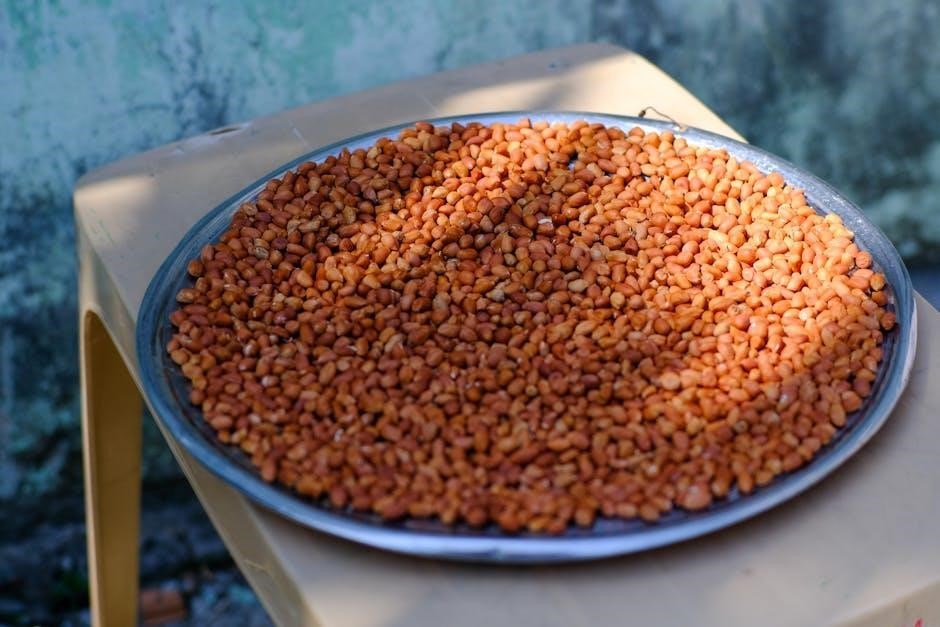The Glycemic Index (GI) is a scale measuring how carbohydrates affect blood sugar levels. It ranks foods from 1 to 100, helping identify which carbs raise blood sugar slowly or quickly. Understanding GI is crucial for managing blood sugar, especially for those with diabetes or prediabetes. By focusing on low GI foods, individuals can make informed dietary choices to maintain stable blood glucose levels and improve overall health outcomes.
1.1 Understanding Glycemic Index and Glycemic Load (GL)
The Glycemic Index (GI) is a scale that ranks carbohydrates based on how quickly they raise blood sugar levels. Foods are categorized as low (GI ≤ 55), medium (56–69), or high (≥70) GI. Glycemic Load (GL) builds on GI by considering portion size, making it a more practical measure. GL is calculated by multiplying the GI of a food by the number of carbohydrates it contains, divided by 100. Low GL foods (GL ≤ 10) have a minimal impact on blood sugar, while high GL foods (GL ≥ 20) cause significant spikes. Understanding both GI and GL helps individuals make informed choices to stabilize blood sugar levels and manage conditions like diabetes effectively.
1.2 Importance of GI in Blood Sugar Management
The Glycemic Index (GI) plays a vital role in managing blood sugar levels, especially for individuals with diabetes or prediabetes. By identifying foods that cause gradual increases in blood glucose, the GI helps prevent spikes and crashes, promoting stable energy levels. This is crucial for maintaining metabolic health and preventing complications associated with erratic blood sugar fluctuations. Incorporating low GI foods into meals can improve insulin sensitivity and overall glucose control; For those managing diabetes, understanding GI is essential for making informed dietary choices. It also supports weight management and reduces the risk of heart disease. Consulting a glycemic food list PDF can provide practical guidance for selecting optimal foods.

The Glycemic Food List PDF
The Glycemic Food List PDF is a free, comprehensive guide listing common foods with their GI values. It helps users make informed choices for blood sugar control and balanced meals.
2.1 Overview of the Glycemic Food List
The Glycemic Food List PDF is a detailed guide that categorizes common foods based on their Glycemic Index (GI) and Glycemic Load (GL) values. It provides a clear overview of how different carbohydrates affect blood sugar levels, helping users make informed dietary choices. The list includes a wide range of foods, from fruits and vegetables to grains and proteins, making it a comprehensive resource for meal planning. Whether you’re managing diabetes or trying to maintain stable blood sugar levels, this list offers valuable insights into selecting foods that align with your health goals. It’s designed to be user-friendly, with organized sections and easy-to-reference formatting.
2.2 How to Access and Download the PDF
The Glycemic Food List PDF is easily accessible online and can be downloaded for free from various health and nutrition websites. Users can visit reputable sources, such as diabetes-focused platforms or nutrition websites, and search for “Low Glycemic Index Food List PDF.” Many websites offer direct download links, allowing quick access to the guide. Additionally, platforms like GitHub or official health organizations may provide downloadable versions. Once downloaded, the PDF can be saved for offline use, printed for reference, or shared with healthcare providers. This convenient format ensures that individuals can easily incorporate the glycemic index into their meal planning and blood sugar management strategies.
2.3 Key Features of the Glycemic Food List PDF
The Glycemic Food List PDF is a comprehensive guide that provides detailed information on the glycemic index (GI) and glycemic load (GL) of various foods. It includes a wide range of common carbohydrates, making it easy to identify low, medium, and high GI options. The PDF is well-organized, with clear categories and searchable functionality, allowing users to quickly find specific foods. It also offers practical tips for meal planning and blood sugar management. Additionally, the guide highlights hidden sugars in processed foods and provides recommendations for balanced eating. This resource is invaluable for individuals with diabetes or those aiming to maintain stable blood glucose levels, offering a user-friendly format for informed dietary choices.

Categories of Foods by Glycemic Index
Foods are categorized into low, medium, and high glycemic index groups based on their impact on blood sugar levels, helping guide healthier dietary choices effectively.
3.1 Low Glycemic Index Foods
Low glycemic index (GI) foods are those with a GI value of 55 or less. These foods, such as whole grains, vegetables, and legumes, digest slowly, resulting in a gradual rise in blood sugar levels. They are ideal for maintaining stable blood glucose, especially for individuals with diabetes or prediabetes. Incorporating these foods into meals helps prevent sharp spikes in insulin levels, promoting better metabolic health. Examples include non-starchy vegetables like broccoli and spinach, whole grains like quinoa and barley, and proteins such as lentils and chickpeas. These foods not only support blood sugar control but also contribute to a balanced and nutritious diet.
3.2 Medium Glycemic Index Foods
Medium glycemic index (GI) foods have a GI value between 56 and 69. These foods cause a moderate rise in blood sugar levels and are suitable for balanced diets. Examples include whole wheat bread, brown rice, and sweet potatoes. They are neither too slow nor too fast in affecting blood glucose, making them a viable option for meals when paired with low GI foods. Incorporating medium GI foods can help maintain stable energy levels without causing significant spikes. Portion control is key, especially for those managing blood sugar, as overconsumption can still impact glucose levels. Balancing these foods with protein and healthy fats can further stabilize their metabolic effects.
3.3 High Glycemic Index Foods
High glycemic index (GI) foods have a GI value of 70 or higher, causing rapid increases in blood sugar levels. Examples include white bread, sugary snacks, white rice, and baked goods. These foods are quickly digested, leading to sharp spikes in glucose levels, which can be problematic for individuals with diabetes or those managing blood sugar. Consuming high GI foods in excess can increase the risk of insulin resistance and metabolic issues. Moderation is key, and pairing these foods with protein or healthy fats can help slow digestion and reduce their impact on blood sugar. Checking the glycemic food list PDF can help identify and manage high GI foods effectively.

Benefits of a Low Glycemic Index Diet
A low glycemic index diet promotes stable blood sugar levels, supports weight management, and enhances heart health by reducing inflammation and improving insulin sensitivity.
4.1 Blood Sugar Control and Diabetes Management
Managing blood sugar is vital for diabetes control. A low glycemic index diet helps stabilize glucose levels by slowing sugar absorption. This reduces insulin spikes, improving diabetes management. Incorporating low GI foods like whole grains and vegetables prevents extreme blood sugar fluctuations, enhancing overall health. Regular monitoring ensures informed food choices, promoting better glycemic control and reducing complications. Balancing meals with protein and healthy fats further supports glucose stability, aiding in long-term diabetes management and improving quality of life for those with the condition.
4.2 Weight Management
A low glycemic index diet aids in weight management by promoting satiety and reducing hunger. Foods with lower GI release glucose slowly, preventing sudden spikes and crashes. This steady energy supply helps control cravings and portion sizes, making it easier to maintain a healthy weight. Additionally, low GI foods often have higher fiber content, which contributes to feelings of fullness. By choosing these options, individuals can avoid overeating and support sustainable weight loss. A balanced diet focused on whole, unprocessed foods not only manages blood sugar but also supports long-term weight management goals effectively.
4.3 Heart Health Benefits
A low glycemic index diet supports heart health by reducing the risk of cardiovascular disease. By stabilizing blood sugar levels, it helps lower triglycerides and LDL cholesterol, both of which are risk factors for heart disease. The fiber-rich, nutrient-dense foods typically found in a low GI diet also improve blood lipid profiles and blood pressure. This approach minimizes inflammation and oxidative stress, further protecting the cardiovascular system. Incorporating heart-healthy foods like whole grains, vegetables, and lean proteins can enhance these benefits. Overall, a low GI diet promotes a healthier cardiovascular system, reducing the likelihood of heart-related complications and improving overall well-being.

Practical Tips for Managing Blood Glucose
Use the glycemic index to guide food choices, balance macronutrients, and stay hydrated. Regular physical activity and mindful portion sizes also help maintain stable blood sugar levels.
5.1 Portion Control and Balanced Meals
Portion control is essential for managing blood glucose, as overeating can lead to spikes. Balanced meals combining low GI foods, protein, and healthy fats slow digestion and stabilize blood sugar. Using the glycemic food list PDF helps identify portion sizes and food combinations that maintain glucose levels. Additionally, reading nutrition labels to check for hidden sugars and saturated fats ensures meals remain balanced. Incorporating whole grains, vegetables, and lean proteins supports overall health and blood sugar regulation. By planning meals with these principles, individuals can achieve better glucose control and reduce the risk of diabetes-related complications, promoting a healthier lifestyle.
5.2 Importance of Monitoring Blood Sugar Levels
Monitoring blood sugar levels is crucial for understanding how different foods affect glucose levels. By checking blood sugar before and after meals, individuals can identify which foods cause spikes and adjust their diet accordingly. This practice helps in making informed choices from the glycemic food list PDF, ensuring better blood sugar control. Regular monitoring also helps prevent complications by maintaining glucose levels within target ranges. It allows individuals to see how their body responds to various foods and portions, enabling personalized adjustments to their meal plans. Over time, this data can guide long-term dietary decisions, promoting better health outcomes and effective diabetes management with the support of a glycemic index guide.
5.3 Balancing Macronutrients in Meals
Balancing macronutrients—carbohydrates, proteins, and fats—is essential for managing blood sugar levels. Carbohydrates have the most significant impact on glucose levels, so choosing low glycemic index options is crucial. Proteins and fats help slow carbohydrate absorption, reducing blood sugar spikes. Pairing carbs with protein or healthy fats, such as avocado or nuts, can stabilize glucose levels. A balanced meal plan from the glycemic food list PDF ensures proper nutrient distribution, promoting steady energy and improved insulin sensitivity. By combining these macronutrients effectively, individuals can maintain blood sugar control while enjoying nutritious, varied meals. This approach supports overall health and complements the benefits of a low glycemic index diet.

Foods to Include in Your Diet
Focus on whole grains, vegetables, lean proteins, and healthy fats. These foods stabilize blood sugar and provide essential nutrients, aligning with the glycemic food list PDF recommendations.
6.1 Whole Grains and Their GI Values
Whole grains are a cornerstone of a healthy diet, offering lower glycemic index (GI) values compared to refined grains. Oats, quinoa, and barley are excellent choices, with GI values typically ranging from 30 to 50. These grains are rich in fiber, which slows digestion and helps maintain steady blood sugar levels. Incorporating whole grains into meals can balance carbohydrate intake and support blood glucose management. The glycemic food list PDF highlights specific whole grains, providing a clear guide for making informed choices. By selecting whole grains, individuals can enjoy nutrient-dense meals that promote long-term health and stabilize energy levels throughout the day.

6.2 Vegetables and Their Impact on Blood Sugar
Vegetables play a vital role in blood sugar management due to their low glycemic index and high nutrient content. Non-starchy vegetables like broccoli, spinach, and bell peppers have minimal impact on blood sugar levels, making them ideal for diabetes-friendly diets. They are rich in fiber, which slows carbohydrate digestion and helps maintain stable blood glucose levels. Starchy vegetables, such as potatoes and corn, have higher GI values and should be consumed in moderation. Incorporating a variety of vegetables into meals balances nutrition and supports overall health. The glycemic food list PDF provides detailed information on vegetable GI values, helping users make informed choices for better blood sugar control and long-term wellness.
6.3 Protein Sources and Their Role in GI Management
Protein sources are essential for managing blood sugar levels due to their minimal impact on the glycemic index. Lean meats, fish, eggs, tofu, legumes, and Greek yogurt are excellent choices as they contain no carbohydrates, thereby not raising blood glucose. Incorporating these proteins into meals helps moderate the digestion of carbohydrates, preventing sudden spikes in blood sugar. This makes them ideal for balancing meals and supporting overall glycemic control. Additionally, protein can enhance satiety, reducing overall carbohydrate intake. The Glycemic Food List PDF offers comprehensive insights into selecting proteins that align with low GI diets, aiding in maintaining stable blood sugar levels and promoting health.

Foods to Limit or Avoid
Foods with high glycemic index values, such as refined sugars and processed carbohydrates, should be limited to prevent rapid blood sugar spikes. These items, ranked high on the GI scale, can destabilize blood glucose levels. Additionally, many processed foods contain hidden sugars, making it essential to check nutrition labels to make informed choices and maintain better blood sugar control.
7.1 High Glycemic Index Foods to Be Aware Of
High glycemic index (GI) foods, such as white bread, pasta, white rice, and sugary snacks, cause rapid blood sugar spikes. These foods, with GI values closer to 100, are typically refined or processed, lacking fiber and nutrients. Consuming them regularly can lead to unstable blood sugar levels, increasing the risk of diabetes and metabolic issues. Identifying these high GI foods is crucial for managing blood sugar effectively. By limiting or avoiding them, individuals can reduce the risk of blood sugar fluctuations and promote better overall health. Recognizing these foods and substituting them with lower GI alternatives is a key step in maintaining a balanced diet.
7.2 Hidden Sugars in Processed Foods
Hidden sugars in processed foods are a significant concern for blood sugar management. Many packaged items, such as cereals, sauces, and snacks, contain added sugars under various names like high fructose corn syrup, dextrose, or maltodextrin. These sugars can cause rapid spikes in blood glucose levels, even in foods marketed as “healthy.” Checking nutrition labels and ingredient lists is essential to identify these hidden sugars. Foods with high glycemic index values often contain these additives, making them unsuitable for low GI diets. Being mindful of these sugars can help individuals make better choices and maintain stable blood sugar levels, aligning with the guidance provided in the glycemic food list PDF.

The Role of Physical Activity
Physical activity enhances insulin sensitivity, helping the body use insulin more effectively and lowering blood sugar levels, which is crucial for managing diabetes and maintaining a healthy lifestyle.
8.1 How Exercise Impacts Blood Sugar Levels
Physical activity plays a vital role in managing blood sugar levels by enhancing insulin sensitivity, which helps the body use insulin more effectively. Regular exercise, such as walking, cycling, or strength training, can lower blood sugar levels by promoting glucose uptake in muscles. Even short bouts of moderate-intensity exercise can improve insulin function for up to 48 hours. Consistent physical activity not only helps stabilize blood glucose but also supports overall cardiovascular health and weight management. For individuals with diabetes, combining exercise with a low-glycemic diet can significantly enhance blood sugar control and reduce the risk of complications. Always consult a healthcare provider before starting a new exercise program.
8.2 Incorporating Activity into Your Daily Routine
Incorporating physical activity into your daily routine is essential for blood sugar management and overall health. Start with short, manageable sessions, such as 10–15 minutes of brisk walking or light exercise, and gradually increase duration and intensity. Scheduling activity after meals can help lower postprandial blood sugar spikes. Even simple movements like stretching or climbing stairs can make a difference. Consistency is key, as regular exercise improves insulin sensitivity and stabilizes blood glucose levels. Combining physical activity with a balanced diet, particularly one focused on low-glycemic foods, enhances the benefits of blood sugar control. Always monitor your blood sugar levels before and after exercise to understand how your body responds and adjust your routine accordingly.

Resources and Support
Accessing resources like the glycemic food list PDF and consulting a dietitian can provide personalized guidance. Online tools and calculators also help manage blood sugar effectively.
9.1 Consulting with a Dietitian
Consulting with a dietitian is crucial for personalized advice on managing blood sugar through the glycemic food list. They create tailored meal plans, focusing on low GI foods, and help identify hidden sugars in processed foods. Dietitians also guide portion control and balanced nutrition, ensuring meals align with individual health goals. Regular follow-ups with a dietitian can track progress and adjust plans as needed. This expertise is especially valuable for those with diabetes or prediabetes, providing a clear roadmap for better blood sugar management. By leveraging their knowledge, individuals can make informed food choices and effectively incorporate the glycemic food list into their daily routines for long-term health benefits.
9.2 Online Tools and Calculators for GI Management
Online tools and calculators are invaluable resources for effectively managing the glycemic index. Websites like Diabetes.ca and Doctors Health Press offer comprehensive glycemic index food lists and glycemic load charts. These tools provide detailed rankings of common foods, helping users make informed choices. Additionally, free recipe nutrition calculators allow individuals to analyze the GI impact of their meals. The Diabetes Plate tool simplifies meal planning by portioning foods to maintain balanced blood sugar levels. These resources empower individuals to track and manage their carbohydrate intake, ensuring they stay within healthy glycemic ranges. By leveraging these tools, users can optimize their diets and achieve better blood sugar control, complementing the guidance from the glycemic food list PDF.
10.1 Summary of Key Takeaways
The glycemic index (GI) is a vital tool for managing blood sugar levels, particularly for individuals with diabetes or prediabetes. By understanding the GI, one can identify which foods cause gradual or rapid blood sugar spikes. The glycemic food list PDF provides a comprehensive guide, categorizing foods into low, medium, and high GI, aiding in informed dietary decisions. Incorporating low GI foods like whole grains, vegetables, and lean proteins supports stable blood glucose levels. Regular monitoring of blood sugar and portion control are also crucial. This approach not only helps in diabetes management but also promotes overall health and well-being, encouraging a balanced and mindful eating lifestyle.
10.2 Encouragement for Healthy Eating
Embracing a low glycemic index diet is a powerful step toward better health; By using the glycemic food list PDF, you can make informed choices that stabilize blood sugar levels and enhance overall well-being. Start by incorporating more whole grains, vegetables, and lean proteins into your meals. Even small changes, like swapping high GI foods for low GI alternatives, can lead to significant improvements. Remember, healthy eating is a journey, and every mindful choice brings you closer to your goals. Stay motivated, and let the glycemic index guide you toward a balanced and nutritious lifestyle that supports long-term health and vitality.
